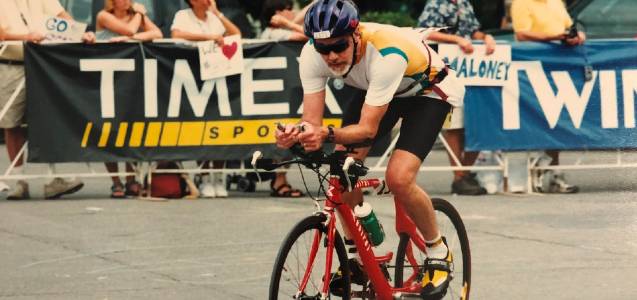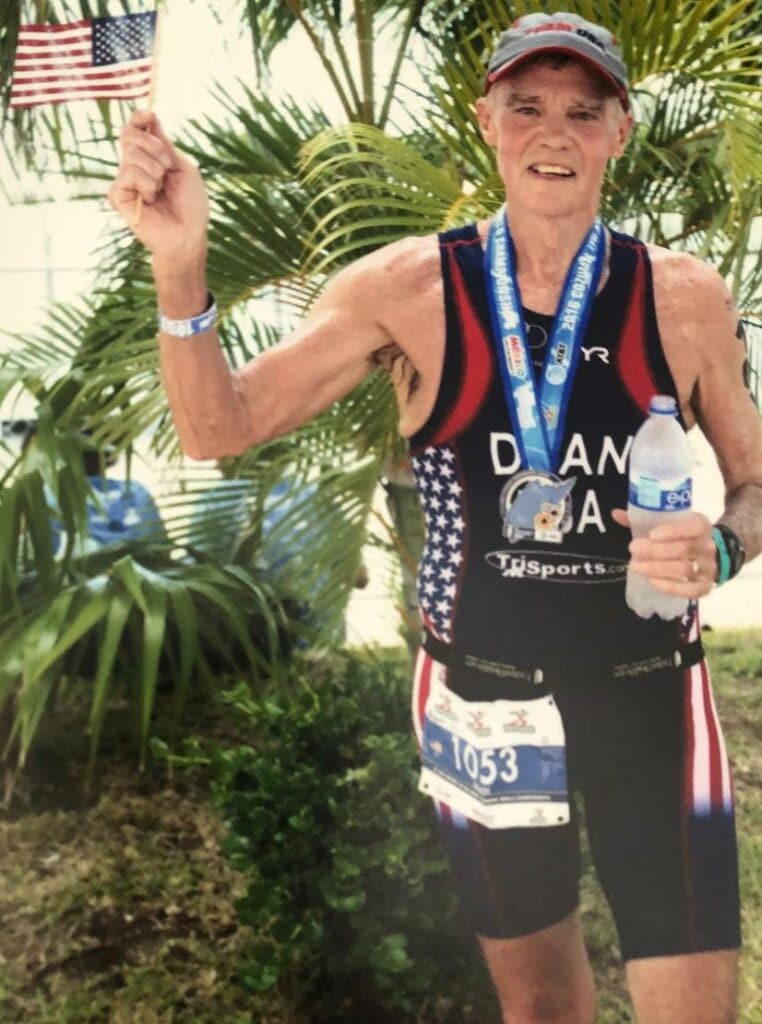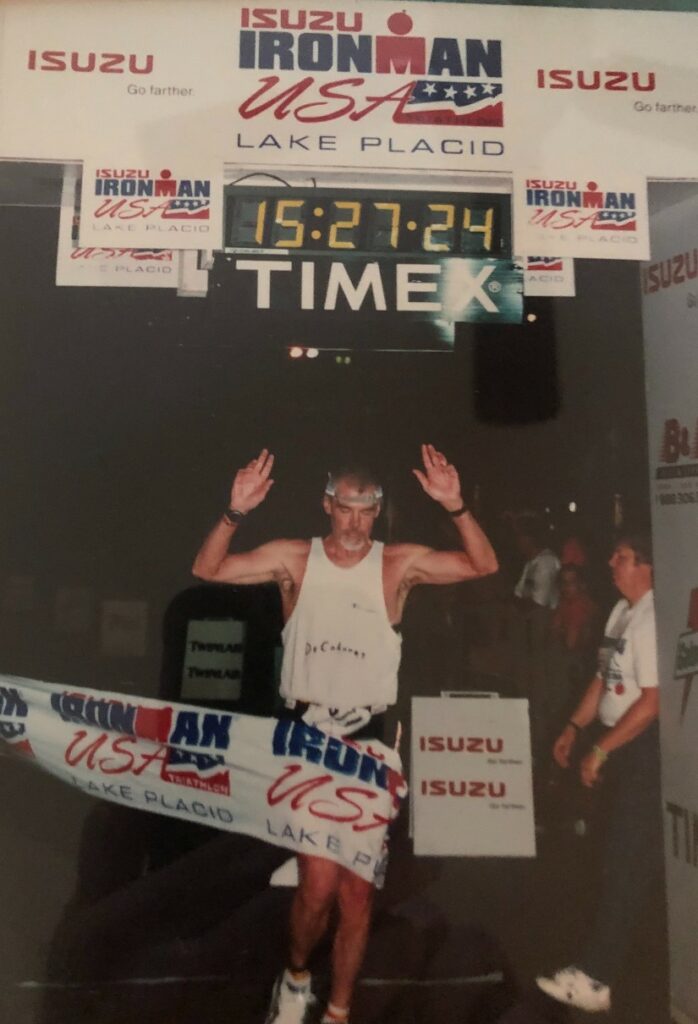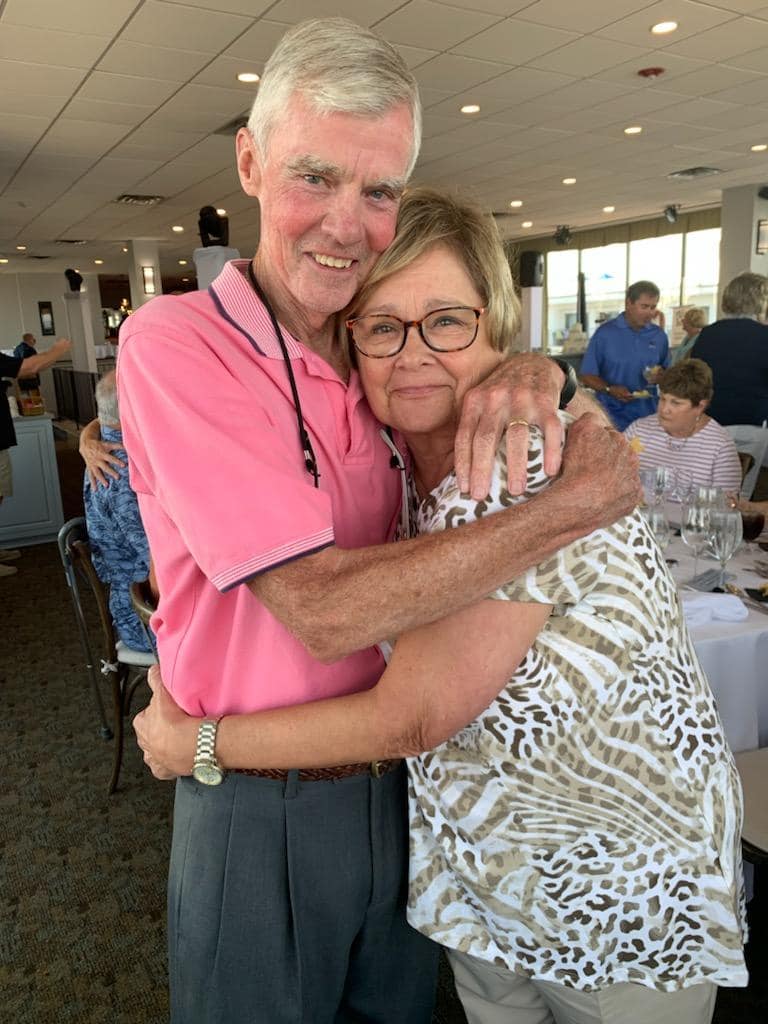101 Triathlons – John Dean’s Story

Have you ever asked yourself, “Should I do a triathlon”?
If you have been thinking about doing your first triathlon or going further with the sport, John Dean is a good guy to know. He has seen and experienced a lot through his 101 (and counting) sprint to Ironman triathlons.
I should warn you that John will most likely tell you to go for it. And, if you are older, he will also tell you “age should not be a limiting factor in triathlon”.
John Dean’s Triathlon History
The Senior Triathletes’ community represents a mix of backgrounds and experiences. Many trained for and completed their first triathlon later in their careers. Others are now training and competing in retirement.
There are also individuals like John Dean for whom triathlon has been a nearly lifelong adventure.
After completing his first triathlon 30 years ago, John continued with the sport. When we spoke recently, he had completed his 101st triathlon.
The Journey Began With Running
John’s path to triathlon began nearly 40 years ago with running. Like many of us, running was a means for him to lose some weight gained after having given up smoking.
John’s initial goal was to complete a 10k race in under 40 minutes and to finish a marathon. He told himself that once he met these goals, it would be time to move on to something a little less strenuous, like fishing or golf.
However, once John easily met those two goals – his first 10k time was around 39 minutes and his first marathon time was 3 hours 25 minutes, he kept going, trying to improve his times.
For the next ten years, John competed in running races from 5k to full marathon distances.
Including his 101 triathlons, John has raced almost 300 times. Most of these have been running races, though he has also done a few duathlons and swim races.
“Should I Do A Triathlon?”
In January, 1992, John’s friend, Peter, invited him to complete a triathlon during August in Norfolk, Virgina. Fearless and eager to take on a new challenge, John answered, ‘Sure, I’ll do that’.
However, after looking deeper into triathlon over the next couple of days, John called his friend. A bit panicked, John asked Peter, “Isn’t there swimming involved in a triathlon?”
Peter confirmed to John that there is swimming in a triathlon. The problem was that John did not know how to swim.
Upon learning this, Peter unsympathetically replied, “Well, you have eight months to learn to swim”.
So, John went to his local pool and spoke to a lifeguard. The conversation went something like this:
Coach: “How far do you need to swim?”
John: “A mile.”
Coach: “How far can you swim?”
John: “How long is the pool?”
Coach: “25 meters.”
John: “In that case, I can swim 24 meters.”
Coach: “Then let’s get to work.”
Those who are holding back from doing a triathlon because they either do not know how to swim or are not comfortable swimming should take heart. John started his inspiring triathlon journey being unable to swim a single length of the pool.
Actual First Triathlon
Not wanting to embarrass himself in front of his friend on race day, John registered for a triathlon near his home before the August race. As luck would have it, one of the Bud Light Series triathlons was scheduled for May in nearby Delaware.
John’s experience with this race, his first triathlon, convinced him he would be ready for the August triathlon, at least enough to not embarrass himself.
Second Triathlon
John’s second triathlon, the one in Norfolk, Virginia in August 1992, was bigger – meaning more participants – than his first. For this race of about 1,200 triathletes, organizers required all triathletes to rack their bikes in the transition area during packet pickup the day before the race.
The next morning, on race day, John arrived while it was still dark to finish setting up his transition area. Much to his shock, his bike appeared to be missing. He wondered, “Why would someone steal my $400 hybrid bike when there are all these $5,000 and even $10,000 bikes here?”.
With a walk around the transition area, he eventually found his bike. He had mistakenly racked it in the wrong place on the previous day. This was the first of many lessons John would learn from triathlon.
John had not set high expectations for this race. So, when he wound up near the middle of all finishers, John decided to continue with triathlon.
John’s Most Memorable Triathlons
It is easy to imagine that out of his hundred-plus triathlons, John has had some wonderful experiences.
What have been John’s most memorable triathlons? He described three.

Racing in Cold, Rainy Weather
A not so pleasant but valuable experience came during one of his early triathlons. This race took place in Columbia, Maryland on a May day John described as “cold, rainy, and miserable”.
His sleeveless wetsuit and bare feet provided little protection against a temperature in the 40s °F. John remembers feeling “cold to the bone” before and during the swim.
The first oddity came during the swim. A group of swimmers donning red swim caps he encountered about three-fourths of the way through the swim had vanished by the time he reached shore at the end of his swim.
Once in the transition area, John had difficulty getting out of his wetsuit. He also fell twice trying to mount his bike. Something seemed off, but he was not sure what was happening.
The feeling that something was wrong continued after he was on the bike. Pedaling was unusually slow and difficult.
Convinced of a problem with the bike, maybe one brake dragging on the rim, John got off the bike to inspect it. He could find nothing wrong, so he remounted the bike and continued with the same difficulty.
Once again, he dismounted and checked his bike. He still couldn’t see anything wrong with the bike.
Fortunately, John eventually realized that he had been riding uphill, a fact he had not grasped prior to this. It was this sense of confusion that suggested to John the possibility of hypothermia.
Now, rather than mount and ride his bike, John ran with his bike on the bike course. As he warmed, he could eventually remount his bike and finish the bike leg and complete the run.
Thankfully, John had recognized the onset of hypothermia before it became more serious.
Racing With the World’s Best Amateur Triathletes
A much more pleasant experience occurred in 2016 after John qualified for the World Team at the USA Triathlon Age Group Championships in Milwaukee, Wisconsin.
He and his wife, Jeanne capitalized on his high place finish at nationals to travel to Cozumel, Mexico, where John competed in the World Championships. After the race, they took some extra days for rest and relaxation in the sun and sand on this Caribbean island.
The course on this Caribbean island was flat. The weather was hot and humid. However, what made this race truly memorable for John was the chance for him to compete alongside some of the world’s greatest age group triathletes.
Becoming an Ironman
John’s sole experience with Ironman came in training for and competing in Ironman Lake Placid (Lake Placid, New York). He enjoyed the experience enough to plan a second Ironman race.
However, while training for it, John realized he would rather skip rocks or play ball with his young grandkids than do a long training ride or run. Acting on this feeling, John changed his plans and returned to focus on shorter distance triathlons.

How John Trains for Triathlon
Early in his triathlon career, John filled some skill gaps in swimming and biking through “several swim coaches and one bike coach”.
As we have already learned, the swim coaches took him from a non-swimmer to one able to complete an Ironman triathlon swim. His bike coach taught him both how to train (“ride lots of miles”) and proper technique (“remember to both pull up and push down to maximize power throughout the stroke”).
After these experiences with coaches, all positive, John returned to self-coaching. He continues today to be his own triathlon coach.
Training as a Lifestyle
Training is an integral part of John’s daily routine. Each week, John trains two days each in swimming, biking, and running. The seventh is a rest day.
On the swim days, John spends at least one hour in a local pool. Over this hour, John will swim a mile through intervals of between 5 and 20 minutes of swimming, separated by brief breaks.
On the two bike days, John typically joins one of two groups for a ride of between 25 and 35 miles. Many of the rides are on the Lewes-Georgetown Trail, a rail trail easily accessed from his home.
As with the swim training, John prefers to run on his own rather than in a group. On these days, he will run between 4 and 8 miles.
This is a typical schedule since John has learned to stay flexible in his training to avoid injury.
What About Technology?
John wears a sports watch with built-in heart rate monitor to track distance, pace, and heart rate. However, he does not actively use metrics from the watch during training.
Instead, John prefers to train based on feel, sometimes referred to as perceived exertion. At the end of each training session or race, he asks “Did I give it my best?”.
John’s Advice for Other Current or Would Be Senior Triathletes
You have a glimpse of where John has come from, his achievements, and how he continues in triathlon.
What are his top pieces of advice for beginner and current triathletes?
#1 – Give It a Try
John’s email signature includes a quote (included below) from author and personal development coach Michelle Landy. John’s belief is that anyone thinking about triathlon should consider her statement.
Triathlon is far from impossible. Many of us are evidence of this, so “give it a try”.
“It’s impossible, said pride,
Michelle Landy, Author and Coach
It’s risky, said experience,
It’ s pointless, said reason,
Give it a try, whispered the heart.”
#2 – Make Time for Recovery
John has learned that we need time for recovery to minimize injury. “We can’t train seven days a week.”
He believes he would still run even if he had not gotten involved in triathlon. However, John is also convinced that, had he continued running without mixing it with swimming and biking or other physical activity, he would have spent more time nursing injuries.
This is a common argument in favor of triathlon over single sports.
#3 – Pay Attention to Nutrition, Especially for Long Course Triathlon
Triathlon training and racing can burn many calories. This is a key appeal for many who get involved with triathlon, especially when weight loss is a goal.
However, in longer training sessions and longer races, it may be necessary to take in calories to supplement those consumed. On top of this, we need to train our bodies to take in these calories while continuing to bike and run to avoid digestive distress.
#4 – Thinking About Ironman? Get Family Buy-in
It takes a certain amount of Type-A personality to compete in triathlon. Therefore, it’s not surprising that many who have done shorter distance triathlons consider competing in longer distance races.
If this is you, first decide if longer distance is a priority. If it is a priority, next get your family’s agreement. The longer the race distance, the longer the training. Training for a half or full Ironman distant triathlon requires many hours each week over several months.
Several other senior Ironman triathletes whose stories I have published have echoed this advice.
Related post: What If I Want to Do An Ironman Triathlon? – Tom Lipp’s Story

Other Benefits
John has experienced another important benefit of training for a triathlon. Swimming, biking, and running are all means of stress relief.
There is even further benefit of endurance sports like triathlon. Medical research has shown that physical activity delays or prevents mental decline. As one example, here is the summary of a 2011 research report.
A rapidly growing literature strongly suggests that exercise, specifically aerobic exercise, may attenuate cognitive impairment and reduce dementia risk.
Ahlskog et al., “Physical Exercise as a Preventive or Disease-Modifying Treatment of Dementia and Brain Aging”, Mayo Clin Proc. 2011 Sep; 86(9): 876–884.
What’s Stopping You?
John recalled his recent conversation with a woman while both were at their local pool for a swim. Upon seeing his Ironman tattoo, she asked him about triathlon.
The conclusion to their conversation was John saying, “Try doing a triathlon. They are fun. Plus, you will meet great people.”
What is holding you back from getting into triathlon?
Please share your questions and concerns with those of our community in the Comments section below.
